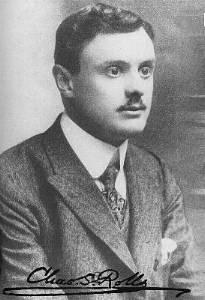In the annals of aviation history, certain names like Charles Rolls shine brightly as pioneers who defied gravity and paved the way for the modern age of flight. Charles Rolls stands out as a figure of remarkable innovation and daring. Born on August 27, 1877, in England, Rolls would become not only a celebrated aviator but also a visionary entrepreneur whose contributions to aviation would shape the course of history.
Early Life and Entrepreneurship of Charles Rolls
Charles Rolls was born into a wealthy family with a passion for engineering and innovation. Educated at Eton College and later at Trinity College, Cambridge, Rolls demonstrated an early aptitude for mechanics and engineering. He was particularly fascinated by the burgeoning field of automobiles, which was undergoing rapid development at the turn of the 20th century. In 1902, Rolls co-founded C.S. Rolls & Co., a dealership that specialized in selling and servicing automobiles. His keen business acumen and passion for engineering soon propelled the company to success, establishing Rolls as a prominent figure in the automotive industry.
Venturing into Aviation
While automobiles captured his initial interest, it was the emerging field of aviation that truly captivated Charles Rolls. In 1903, just months after the Wright brothers’ historic flight at Kitty Hawk, Rolls became one of the first Britons to fly in an airplane. This experience ignited his fascination with flight, and he soon became determined to push the boundaries of aviation. In 1908, Rolls achieved another milestone when he became the first person to make a non-stop double crossing of the English Channel by plane. This feat demonstrated his skill as a pilot and showcased the potential of aviation for long-distance travel.
Charles Rolls and his Partnership with the Wright Brothers
One of Rolls’ most significant contributions to aviation came through his partnership with the Wright brothers, Orville and Wilbur. Recognizing the revolutionary potential of their aircraft designs, Rolls secured the rights to sell Wright aircraft in the United Kingdom. This partnership not only helped popularize aviation in Britain but also played a crucial role in advancing aircraft technology.
Founding of Rolls-Royce Limited
In 1906, Charles Rolls made history yet again when he co-founded Rolls-Royce Limited, a company that would become synonymous with luxury and engineering excellence. Initially focused on manufacturing automobiles, Rolls-Royce later diversified its operations to include aircraft engines, thanks in part to Rolls’ foresight and enthusiasm for aviation.
Tragic Legacy
Despite his many achievements, Charles Rolls’ life was tragically cut short in 1910 when he became the first Briton to die in an airplane accident. While performing a demonstration flight at the Bournemouth Aviation Week, his aircraft experienced a structural failure, leading to a fatal crash. Rolls’ untimely death was a somber reminder of the risks inherent in early aviation but did little to diminish his legacy as a pioneering aviator and entrepreneur.
Wrapping it Up
Charles Rolls’ contributions to aviation were nothing short of groundbreaking. His daring flights pushed the boundaries of what was thought possible, while his entrepreneurial ventures helped shape the nascent aviation industry. His partnership with the Wright brothers and the founding of Rolls-Royce Limited laid the groundwork for decades of innovation in aerospace technology. Today, Charles Rolls is remembered not only as a skilled aviator but also as a visionary who helped usher in a new era of human flight. His legacy continues to inspire future generations of pilots, engineers, and entrepreneurs, reminding us that with determination and innovation, anything is possible in the limitless skies above. That’s a wrap for this week, until next time remember to Be Social, Fly Private!

